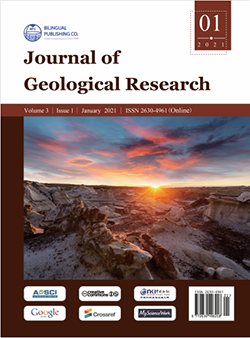Petrographic Study of Sedimentary Iron Ore in Shendi-Atbara Basin,River Nile State, Sudan
DOI:
https://doi.org/10.30564/jgr.v3i1.2814Abstract
This paper presents the results of petrographic study of sedimentary iron ore from surface strata of the Shendi-Atbara Basin, River Nile State, Sudan. The aims of this study are to investigate the geological behavior and geological conditions affecting precipitation of sedimentary iron ore. The methodologies have been used to realize the objectives of this study include field work, office work and laboratory work including thin sections and polished sections analysis. According to field observation sedimentary iron ore can broadly be considered as occurring in three major classes:Ferribands iron, ferricrete iron and oolitic iron ores. The modes of occurrence of iron ore were described at the outcrops and vertical sedimentary profiles revealed that the iron occurred in the study area at different types in stratigraphic sequence such as cap, bedded and interbedded conformable with Shendi Formation. Petrographic study of iron ore in collected samples using polarized microscope and ore microscope includes study of the textures and structures of ores to obtain ore history. The main types of textures and structures in studied samples are oolitic, granular, lamellar and bands.According to these results the origin of iron ore is formed by chemical precipitation during chemical weathering of surrounding areas in continental lacustrine environment. The iron ore in study area is potential for future mining works and steel industry
Keywords:
Petrographic; Iron ore; Shendi formation; Conformable; TexturesReferences
[1] Abubaker, A. M. A. Abasher (2020), Sedimentary iron Ore Deposits and Associated Manganese in Shendi-Atbara Basin, River Nile State, Sudan M. Sc.thesis, International University of Africa., Sudan.
[2] Whiteman, A. J. (1971), The geology of the Sudan Republic. London Clarendon Press: Oxford, 290 pp.
[3] Vail, J. R. (1983), Pan-African crustal accretion in north-east Africa. - J. Afi-. Earth Sci., 1 (3-4), 285-294, Oxford.
[4] Delany, F.M. (1955), Ring structures in the northern Sudan. Eclogae Geologicae Helvetiae, 48,133-148.
[5] Vail, J.R., (1990), Geochronology of the Sudan.Overseas Geol. Miner. Resources 66,58.Vermeersch,P.M., 2001. ‘Out of Africa’ from an Egyptian point of view. Quaternary Int. 75,1030- 1112.
[6] Kheiralla, M. K. (1966), A study of the Nubian sandstone formation of the Nile Valley between 12°N and 17°42’N with reference to the groundwater geology.M.Sc. Thesis. Khartoum, Sudan:University of Khartoum.
[7] Cox, L.R, (1932), On fossiliferous siliceous boulders from the Anglo-Egyption Sudan abstract.Proc. Geol. Soc. Lond., No.1254, pp.17-18.
[8] Andrew, G. And karkains, G. Y. (1945), stratigraphical notes, Anglo-Egyptian sudan. Sudan notes REC.26-157-66.
[9] Anderw, G (1948), The geology of the sudan.PP84-128 in agriculture in the Sudan. Tothill, J.D.(Editor).(London: Oxford University).
[10] Vail, J. R. (1971), Geological reconnaissance in part of Berber District, Northern Province, Sudan. - Bull.Geol. Survey Sudan, 18, 76 pp., Khartoum.
[11] Almond, D.C, (1969), Structure and metamorphism of the basement complex of NE Uganda. Overseas Geol. Miner. Resources 10, 146-163.
[12] Almond, D.C. (1977), The sabaloka igneous complex, sudan. Trnasaction of royal society in London.B., 287. No. 1348, P.595-633.
[13] Vail, J.R., (1978), Outline of the geology and mineral deposits of the Democratic Republic of the Sudan and adjacent areas. Overseas Geol. Miner. Resources 49, 67.
[14] Abdirasak A.H. (2019), Application of resistivity and remote sensing techniques for the groundwater investigation in the sabaloka complex – river Nile state,Sudan, M. Sc thesis, pp 12.
Downloads
How to Cite
Issue
Article Type
License
Copyright © 2021 Abubaker A. M. A. Abasher, Sadam H.M.A. Eltayib, El Sheikh M. Abdelrahman, Mohammed M.A. Amlas

This is an open access article under the Creative Commons Attribution-NonCommercial 4.0 International (CC BY-NC 4.0) License.
Copyright and Licensing
The authors shall retain the copyright of their work but allow the Publisher to publish, copy, distribute, and convey the work.
Journal of Geological Research publishes accepted manuscripts under Creative Commons Attribution-NonCommercial 4.0 International License (CC BY-NC 4.0). Authors who submit their papers for publication by Journal of Geological Research agree to have the CC BY-NC 4.0 license applied to their work, and that anyone is allowed to reuse the article or part of it free of charge for non-commercial use. As long as you follow the license terms and original source is properly cited, anyone may copy, redistribute the material in any medium or format, remix, transform, and build upon the material.
License Policy for Reuse of Third-Party Materials
If a manuscript submitted to the journal contains the materials which are held in copyright by a third-party, authors are responsible for obtaining permissions from the copyright holder to reuse or republish any previously published figures, illustrations, charts, tables, photographs, and text excerpts, etc. When submitting a manuscript, official written proof of permission must be provided and clearly stated in the cover letter.
The editorial office of the journal has the right to reject/retract articles that reuse third-party materials without permission.
Journal Policies on Data Sharing
We encourage authors to share articles published in our journal to other data platforms, but only if it is noted that it has been published in this journal.




 Abubaker A. M. A. Abasher
Abubaker A. M. A. Abasher

